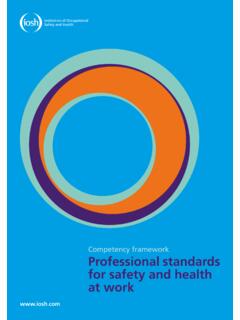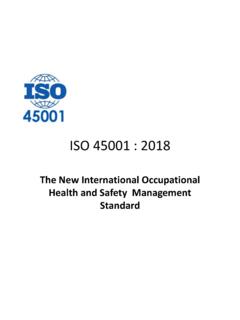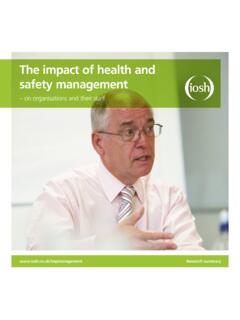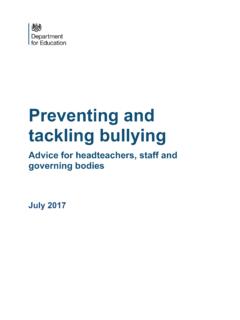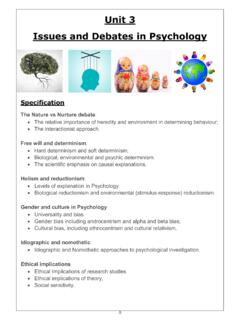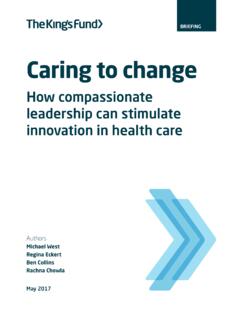Transcription of Occupational health management in the workplace
1 Occupational healthmanagement in the workplaceA guide to the key issues of Occupational health provisionIOSH publishes a range of free technical guidance literature is designed to support and inform members, and to motivate and influence safety and health health management in the workplace a guide to the key issues of Occupational health provision The effective management of health risks , as well as safety risks , is an essential part of good health and safety management systems. When riskmanagement is integrated into the core business functions, real change and improvement can be seen not only by preventing physical and mental harm to employees, but also by improving business first part of this guide aims to provide Occupational safety and health (OSH) practitioners and other business professionals with guidance on identifying, controlling and measuring health risks in the workplace .
2 The second part focuses on the aspects to consider when providing Occupational health effectiveness of any health management relies on the competence and capability of those providing it. In the case of Occupational health services, there are many crucial elements to be aware of and these are set out in this guide whether you re providing them in-house or contracting you have any comments or questions about this guide, please contact Information and Intelligence at IOSH:- t +44 (0)116 257 3100- versions of this and other guides are available at materials are reviewed at least once every three years. This document was first published in October 2016. This document was last reviewed and revised in March 2018 This publication contains public sector information published by the health and Safety Executive and licensed under the Open Government workplace health is on the agenda, after decades as the Cinderella to safety.
3 But what is this rather mysterious, seemingly complex, scientific-clinical, multi-disciplinary area all about? That s a great question and one this guide attempts to begin to answer for Occupational safety and health (OSH) practitioners. Whenever anyone tells me their organisation does health , I always begin by saying Great, but what sort of health do you mean? At that point, more often than not, they look a little puzzled and I go on to explain that the health word has been both confusinglyused and regularly misunderstood. Simply put, there are three broad and overlapping spheres of health in the workplace , as the overview on page 02 of this guide explains: managing the health of the worker; managing the health risks created by the workplace ; and managing the wellbeing ofthe workforce.
4 In simple terms, the delivery of these three spheres is led respectively by Occupational clinicians, Occupational hygienists and Occupational health professionals, though with areas of overlap as I ve indicated. This guide tries to unpack some of the mystery around these scientific-clinical disciplines and their approaches to the management and control of health risks at work. It is a welcome addition to raising awareness and understanding of workplace health , complementing the many resources available for workplace successful management and control of workplace safety risks has been one of the major Occupational success stories of the last century (if only people were aware of it). I hope and believe that the successful management and control of workplace health risks can be the major Occupational success story of the next century.
5 In view of the huge burdenof work-related health morbidity and mortality, it certainly should PerkinsChief ExecutiveBOHSC ontentsOverview of health aspects in businessWhy managing health at work is harder than safety Understanding health risks in the workplace When to assess individual health Choosing an Occupational health service Appendices Acknowledgment02030408121827 List of figures1 Aspects of health in business 2 health risks in the workplace3 Conceptual spectrum of leading to lagging indicators List of tables1 Simple, non-confidential health questionnaire2 Issues to consider if delivering services on site List of flowcharts1 Pre-placement health assessment2 Consent for GP report 0206110815102202 Overview of health aspects in businessHistorically, health in the workplace has had little focus.
6 As a result, ill health caused by work costs individuals, business and public services billions each year. The hidden costs for the individual who has been made ill by work are incalculable not being able to play with their children or grandchildren; not being able to walk to the shops; and often a slow and painful things are changing health is now on the agenda for business and governments. Business recognises that a healthy workplace is a happy and productive one; governments recognise that business has a leading role in preventing ill health andpromoting good health . Individuals are also recognising how important their health is: older workers recognise they need to stay fit and healthy to work; and younger generations expect their employers to actively provide healthy workplaces, not ones that merely protect them from harm.
7 health activities in business are often multi-faceted with multi-disciplinary approaches. This can cause confusion and result in the most important aspect health risk being overlooked as the trendier and easier wellbeing activities take centre is critical, therefore, that OSH practitioners and business leaders make sure that health risks remain at the heart of health management . Figure 1 sets out the hierarchy of health aspects in a business and outlines multi-disciplinary teams that have a role in each. Occupational disease and illness can be prevented, provided risks are properly eliminated, managed and requires a concerted effort by everyone to recognise the hazards to health , evaluate the degree ofexposure, and implement effective and reliable control 1.
8 Aspects of health in businessHealth risks - Identifying- Assessing - Controlling- Monitoring and reviewing- OSH practitioners, Occupational hygienists, Managers, EmployeesHealth management - Fit for role- Sickness absence, including rehabilitation- Case management - Occupational health , Managers, HR, OSH practitioners, EmployeesHealth promotion- Educating- Encouraging- Facilitating- HR, Managers, Employees, Occupational health , OSH practitioners03 Why managing health at work is harder than safetyIn the case of a safety hazard, anyaccident that results from it is generallythe same: for example, a spillage of oil on a hard floor will probably cause a slip, trip or fall. But when dealing with health hazards, the effect on health is complicated, often not immediate, and individuals exposed to such hazards don t always react in the same and OSH practitioners need to be aware of the differences between the health and safety aspects of a risk assessment, and where there is need to have a clear understanding of the health risks in their business and how these affect employees, more vulnerable individuals and others (contractors and the public, for instance).
9 By working with suitable professionals to identify the risks , assess them, identify suitable controls, monitor those controls and, where needed, carry out risk assessments for individuals, an organisation will greatly improve its OSH understanding and is not straightforwardConsider smokers or sunbed users why risk such activities when they increase one s chances of illness, or even death? The answer lies in a person s beliefs, lifestyle, education and attitude to risk, as well as the fact that many smokers and sunbed users usually show no obvious short-term ill effects. Individual characteristics such as age, genetics, gender , ethnicity, medical history and nurture influence health outcomes too, which makes the practice of predicting health risks highly is not instantMany Occupational ill- health problems manifest years after the work that caused the problem has finished.
10 Take asbestos, for instance, which kills over 3,000 people in the UK each year, 1 from exposures 10, 20, 30, 40 or more years raise awareness of health risks , Park health , which provided Occupational health services during the construction of the Olympic Park in London, described health damage as the slow accident a reflection of the fact that health problems are slow moving, yet their effects can be just as dramatic as is not logicalThe way people react and behave for example, how they recover after head injuries or experience pain can be influenced by their personal beliefs and past experiences. Medicalprofessionals recognise this behaviour as the biopsychosocial model, which explains how a person s health is deeply affected by non-medical factors.

